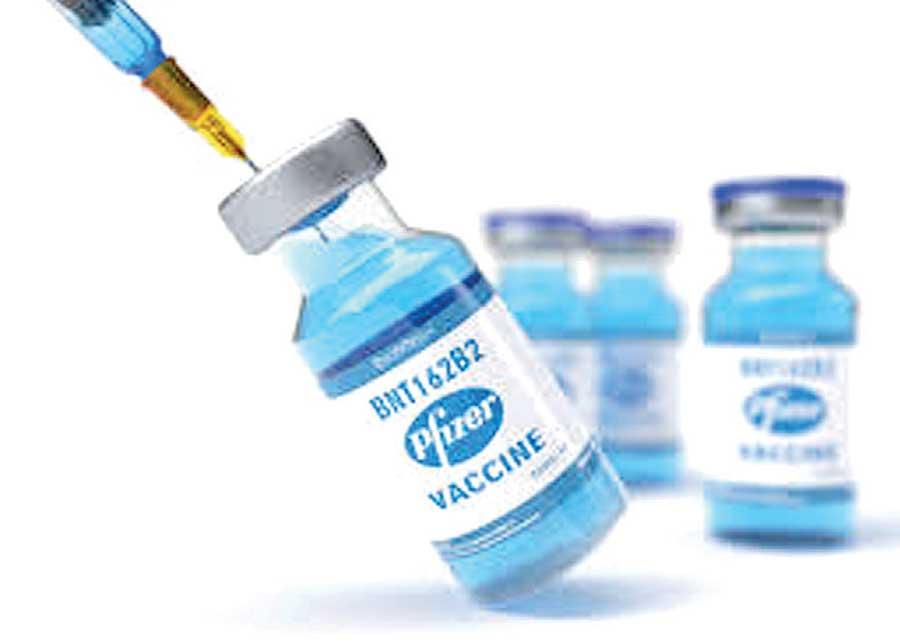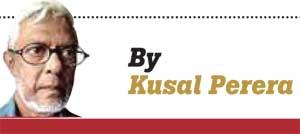Reply To:
Name - Reply Comment

- Unless these countries develop their own preventive and control measures, they will have to live through 2021 with miserably failed WHO guidelines
- Why developing countries should ignore WHO and formulate own COVID-19 prevention measures
The second wave of the COVID-19 pandemic that is more a The Colombo-centred spread shows the larger number of infected persons from the 16,311 reported as at December 23 since October 4 and also deaths are from the Colombo Municipal Council areas that are most crowded and cramped where most “underserved settlements” (Slums addressed diplomatically) are located
the Colombo Municipal Council areas that are most crowded and cramped where most “underserved settlements” (Slums addressed diplomatically) are located
Fifteen of the isolated Police divisions and Grama Niladhari divisions are in these most densely populated areas
Social distancing with regular handwashing and face masks have meanwhile come to stay with COVID-19 pandemic
Around 200 countries accept WHO guidelines in control and prevention including Sri Lanka. WHO is “the Supreme authority” in deciding everything related to control and prevention of the COVID-19 pandemic. WHO has a proud history. That was in the decades of 50 and 60. An era most UN agencies responded to their global responsibilities and duties with a high level of independence, professionalism and integrity
The UN system as a whole has gradually lost that trust and faith during the past 40 plus years in a global market economy dominated by giant corporate mafias
One of them is the Pharmaceutical industry. All UN agencies are funded by first-world economies dominated by these corporate mafias. A policy paper researched and prepared in 2017 by Brookings Institution in Washington DC by two of its key personalities, John McArthur a Senior Fellow, Global Economy and Development and Ms Krista Rasmussen a Senior Research Associate of Policy Planning – UN Foundation reveals 34 UN organisations among 53 major multilateral entities are funded by first world countries and by Bill and Melinda Gates Foundation (BMGF)
The policy paper calculates 03 of the major funders as the US, UK and Japan funding 43 of the 53 major multilateral entities they had covered. BMGF is mentioned as the second-largest funder to the 03 organisations: Gavi the vaccine alliance, the WHO and the Consultative Group for International Agricultural Research (CGIAR)
Heavily funded by big funders, the WHO and its programmes are not decided for and by the poor. The Borgen Project, a non-profit organisation working on poverty and hunger, analysing the achievements of UNDP initiated MDGs said, “….many of the Millennium Development Goals (MDGs) were not complete successes, and some failed outright.” Failed, because none were designed for the poor and developing countries. So are SDGs
A classic example is Sri Lanka. Long before MDGs Sri Lanka had eradicated epidemics like malaria, cholera, smallpox and poliomyelitis by the middle of the decade of 60. This within a free health service with community-based “preventive healthcare”
Gains were many. Beyond eradication of regular epidemics, a very healthy society was established that could even today stand proud with an extremely low maternal mortality rate of 0.34 per 100 live births by 1985 while the SDG target in 2015 was 0.7 per 100 births. Onsite sanitation reached 80 per cent by the end of the decade of 70. As the first country in Asia that switched to a The neo-Liberal market economy in 1978, community-based preventive healthcare was abandoned for curative healthcare with private sector investments
This led to fee levying private medical consultations and treatment, private hospitals with very sophisticated and expensive laboratory services and a new and a large growing market for drugs. Most importantly with a new mindset created that accepted private healthcare as modern and of high quality
"One of them is the Pharmaceutical industry. All UN agencies are funded by first-world economies dominated by these corporate mafias"
With the State sector community-level preventive health services neglected, the growing Dengue epidemic could not be managed even before COVID-19 arrived. The worst the year 2017 reported 186,101 cases and 440 deaths. During the four years from 2016 to 2019, there had been 665 dengue fatalities with over 380,000 suspected cases
The WHO with its SDGs does not promote preventive community healthcare regimes. All WHO interventions accept commodifying health in a free market economy
“Sri Lanka Voluntary National Review on the Status of implementing SDG – June 2017,” says, “….more than half of the total health expenditure in the country is a private expenditure, out of which 83% is out-of-pocket payments by households.” (p/74) It is this market based curative health service the WHO works on
Accordingly, all health guidelines provided by the WHO in preventing COVID-19 pandemic allow massive space and time for giant pharmaceutical corporates to experiment on a COVID-19 vaccine to the largest ever market demand in history
A joint survey carried out by the Mumbai Municipality, the government thinktank Niti Aayog and the Tata Institute of Fundamental Research records 57 per cent of the 7,000 slum dwellers had tested positive
Around 65 per cent of the 12 million Mumbai population lives in awfully cramped, airless slums that is good ground for the virus spread
The survey in June also noted that only 16 per cent of those living outside the slums were exposed. Also in June, DownToEarth an investigative web journal said the Indian government had accepted “overcrowding in slums makes social distancing and self-quarantine unrealistic.” Johns Hopkins University in September said the US, Brazil, India and Mexico account for more than 50 per cent of the deaths worldwide. And the largest number of infections and deaths worldwide are among the urban poor. A research document published on August 05 by “JAMA Network Open” an open-access medical journal published by the American Medical Association, titled “Assessment of Community-level Disparities in COVID-19 infections and Deaths in large US Metropolitan Areas” that covered 10 major US cities like NY and Chicago have noted, “larger structural factors are at play that causes marginalised and minoritized groups to have worse outcomes.” The co-author of this research document, an Assistant Professor at the NY University’s Grossman School of Medicine, Samrachana Adhikari, PhD is quoted as saying, “But looking at the high-poverty areas, they were being hit nine times higher and that was a stark number.” Now the trillion-dollar question is, with over 1.7 million COVID-19 deaths reported worldwide so far (end November), why are we still, sticking to WHO health guidelines that have failed miserably? Why are we enforcing unrealistic and unpracticable social distancing, handwashing with sanitisers and self-quarantine on 01 billion-plus people (According to SDG indicators) living in slums and poverty? Also, on additional numbers in millions that account as marginalised population and on over another 40 to 60 million who are being dragged into poverty (Phil Crehan at WEF on 26 June) within the shattered global economy? When WHO guidelines are not applicable nor relevant to well over 02 billion of the 7.8 billion world population? Where these lower social segments among whom WHO prescribed prevention measures are not relevant and not applicable, the keyword for permitting social life as before was “herd immunity”. This hypothetical assumption that “herd immunity” would provide answers failed in all countries and led to a second wave within about 06 months and was far harsher than the first wave
With COVID-19 pandemic threatening life all through the year, the second wave in crumbling economies left large populations helpless, scared and demanding answers. Frustration and desperation of the majority of ordinary people can be seen in large crowds that keep gathering in Kegalle, Sri Lana for a fake, never proven syrup claimed as a cure for COVID-19 by a self-acclaimed messenger of God Kaali
They also reflect on one side the massive demand for the “vaccine” touted as the only answer and on the other, the time gained by mega pharmaceutical corporates in researching and developing a vaccine supported and facilitated by the WHO
Now the WHO is left out with the First World countries allowing three vaccines for human use, though third phase final trials are not over
The US and the EU kickstarted the process of providing emergency approval for US Pfizer and German BioNTech collaborated “double dose” vaccine branded Comirnaty. The cryptic name consists of different parts, each with a meaning: Covid-19, mRNA, Community and Immunity.
By December 24, there were other countries including Argentina, Chile, Costa Rica, Ecuador, Mexico, Panama, Kuwait and Singapore joining this caravan for Comirnaty vaccine. Meanwhile, Canada, Saudi Arabia and Bahrain had given total approval
A news release by BioNTech SE on 23 December informs the The US that had purchased 100 million doses of Comirnaty had ordered another 100 million doses to be delivered in total before 31 July 2021. The EU will be purchasing 200 million doses of Comirnaty before end of the year 2020 with an agreement for another 100 million doses in 2021. News reports say, almost 80 per cent of the vaccine production had already been purchased by about 40 countries including the US, Canada and the EU
This leaves the poor and developing countries starving for a vaccine. On 24 August 2020, the WHO issued a news release that said, “172 economies are now engaged in discussions to potentially participate in COVAX, a global initiative aimed at working with vaccine manufacturers to provide countries worldwide equitable access to safe and effective vaccines, once they are licensed and approved.” Since then, the WHO through whatever facilitating tool has not guaranteed “equitable access to safe and effective vaccines” to poor and developing countries so far and that includes Sri Lanka too, whatever local news reports indicate
In plain language, it means the poor and developing countries will have to live through 2021 with remote chances of having a vaccine. Therefore, unless these countries develop their own preventive and controlling measures, they will have to live through 2021 with miserably failed WHO guidelines
Unspoken truth is, in this free market economy where WHO and health are controlled by mega Pharmaceutical Corporates the poor and developing countries are not priorities. They, therefore, have to define and design their fate outside global agencies for the benefit of its poor Citizens. That is no different in Sri Lanka.